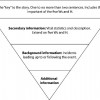 In order to write a good news story for print, television, or radio, you have to conduct interviews with the people who have the information you need. An interview is the process of asking good questions so you can get good answers for your news story. This 3-page fact sheet provides some tips to follow as you conduct a news story interview. Written by Ricky Telg, and published by the UF Department of Agricultural Education and Communication, January 2015. (Photo: VStock/Thinkstock.com)
In order to write a good news story for print, television, or radio, you have to conduct interviews with the people who have the information you need. An interview is the process of asking good questions so you can get good answers for your news story. This 3-page fact sheet provides some tips to follow as you conduct a news story interview. Written by Ricky Telg, and published by the UF Department of Agricultural Education and Communication, January 2015. (Photo: VStock/Thinkstock.com)
http://edis.ifas.ufl.edu/wc194
Tag: News Media Writing
News Writing for Television and Radio
 Creating a television or radio story is more than hitting “record” on a video camera or audio recorder. You have to learn the process of writing an effective television and radio news story first. This 4-page fact sheet was written by Ricky Telg, and published by the UF Department of Agricultural Education and Communication, January 2015.
Creating a television or radio story is more than hitting “record” on a video camera or audio recorder. You have to learn the process of writing an effective television and radio news story first. This 4-page fact sheet was written by Ricky Telg, and published by the UF Department of Agricultural Education and Communication, January 2015.
http://edis.ifas.ufl.edu/wc193
Grammar and Punctuation
 Any news story should be as free of grammar and punctuation errors as possible. Grammar is a system of rules that defines the use of the language. Most of the grammar and punctuation rules you have learned in school will be the same when using Associated Press Style, but there are some differences. This 4-page fact sheet covers some common grammatical and punctuation issues for journalists. Written by Ricky Telg, and published by the UF Department of Agricultural Education and Communication, January 2015. (Photo: iStock/Thinkstock)
Any news story should be as free of grammar and punctuation errors as possible. Grammar is a system of rules that defines the use of the language. Most of the grammar and punctuation rules you have learned in school will be the same when using Associated Press Style, but there are some differences. This 4-page fact sheet covers some common grammatical and punctuation issues for journalists. Written by Ricky Telg, and published by the UF Department of Agricultural Education and Communication, January 2015. (Photo: iStock/Thinkstock)
http://edis.ifas.ufl.edu/wc192
News Writing for Print
 A good print news story will contain the following components: inverted pyramid structure, five Ws and H, leads, impersonal reporting, news writing techniques, quotations and attributions, Associated Press Style, and proper grammar and punctuation. This 5-page fact sheet was written by Ricky Telg, and published by the UF Department of Agricultural Education and Communication, January 2015.
A good print news story will contain the following components: inverted pyramid structure, five Ws and H, leads, impersonal reporting, news writing techniques, quotations and attributions, Associated Press Style, and proper grammar and punctuation. This 5-page fact sheet was written by Ricky Telg, and published by the UF Department of Agricultural Education and Communication, January 2015.
http://edis.ifas.ufl.edu/wc191
News Media Writing
 Knowing how to write in a news media style is important not only for an organization’s reporters, but also for its members. This 2-page fact sheet provides an overview of news writing for print, television, and radio to help you better communicate news about what is going on in your organization. Written by Ricky Telg, and published by the UF Department of Agricultural Education and Communication, January 2015.
Knowing how to write in a news media style is important not only for an organization’s reporters, but also for its members. This 2-page fact sheet provides an overview of news writing for print, television, and radio to help you better communicate news about what is going on in your organization. Written by Ricky Telg, and published by the UF Department of Agricultural Education and Communication, January 2015.
http://edis.ifas.ufl.edu/wc190